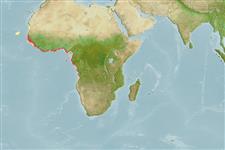Issue
Distribution will be corrected.
Environment: milieu / climate zone / depth range / distribution range
Ekologi
laut; payau dasar (demersal); kisaran kedalaman 1 - 60 m (Ref. 4438). Tropical; 21°N - 17°S
Eastern Central Atlantic: Senegal to Congo (Ref. 114953).
Size / Weight / umur
Maturity: Lm ? range ? - ? cm
Max length : 100.0 cm WD jantan/; (Ref. 3170); common length : 60.0 cm WD jantan/; (Ref. 26999); Berat maksimum terpublikasi: 20.0 kg (Ref. 81259)
vertebrata, bertulang belakang: 130. Diagnosis: A large Dasyatis species most closely related to the much smaller Dasyatis margaritella and to the extremely flat D. garouaensis (Ref. 26277). Pearl spines always present and very large; denticles on dorsal surface of disc smooth, restricted to middle portion (Ref. 26277).
Dasyatis margarita is a coastal marine species, entering lagoons, shallow bays and estuaries (Ref. 3497, 81259). Feeds on shrimps, crabs, bivalves and annelids (Ref. 28587). Ovoviviparous (Ref. 50449).
Life cycle and mating behavior
Maturities | Reproduksi, perkembang biakan | Spawnings | Egg(s) | Fecundities | Larva
Exhibit ovoviparity (aplacental viviparity), with embryos feeding initially on yolk, then receiving additional nourishment from the mother by indirect absorption of uterine fluid enriched with mucus, fat or protein through specialised structures (Ref. 50449). Distinct pairing with embrace (Ref. 205).
Capapé, C. and M. Desoutter, 1990. Dasyatidae. p. 59-63. In J.C. Quero, J.C. Hureau, C. Karrer, A. Post and L. Saldanha (eds.) Check-list of the fishes of the eastern tropical Atlantic (CLOFETA). JNICT, Lisbon; SEI, Paris; and UNESCO, Paris. Vol. 1. (Ref. 4438)
Status IUCN Red List (Ref. 130435)
ancaman kepada manusia
Harmless
penggunaan manusia
Perikanan: komersial
Alat, peralatan
laporan khas
muat turun XML
Sumber internet
Estimates based on models
Preferred temperature (Ref.
123201): 23 - 28, mean 26.5 °C (based on 76 cells).
Phylogenetic diversity index (Ref.
82804): PD
50 = 0.5156 [Uniqueness, from 0.5 = low to 2.0 = high].
Bayesian length-weight: a=0.00832 (0.00366 - 0.01891), b=3.10 (2.90 - 3.30), in cm total length, based on LWR estimates for this (Sub)family-body shape (Ref.
93245).
Trophic level (Ref.
69278): 3.4 ±0.50 se; based on food items.
Daya lenting (Ref.
120179): Rendah, Waktu penggandaan populasi minimum 4.5 - 14 tahun (Assuming fecundity<100).
Fishing Vulnerability (Ref.
59153): Very high vulnerability (90 of 100).
Nutrients (Ref.
124155): Calcium = 34.7 [8.3, 159.9] mg/100g; Iron = 0.765 [0.192, 2.007] mg/100g; Protein = 21.9 [19.0, 24.9] %; Omega3 = 0.174 [0.049, 0.512] g/100g; Selenium = 41.1 [11.0, 113.3] μg/100g; VitaminA = 13.3 [5.9, 29.3] μg/100g; Zinc = 1.1 [0.5, 2.0] mg/100g (wet weight);
